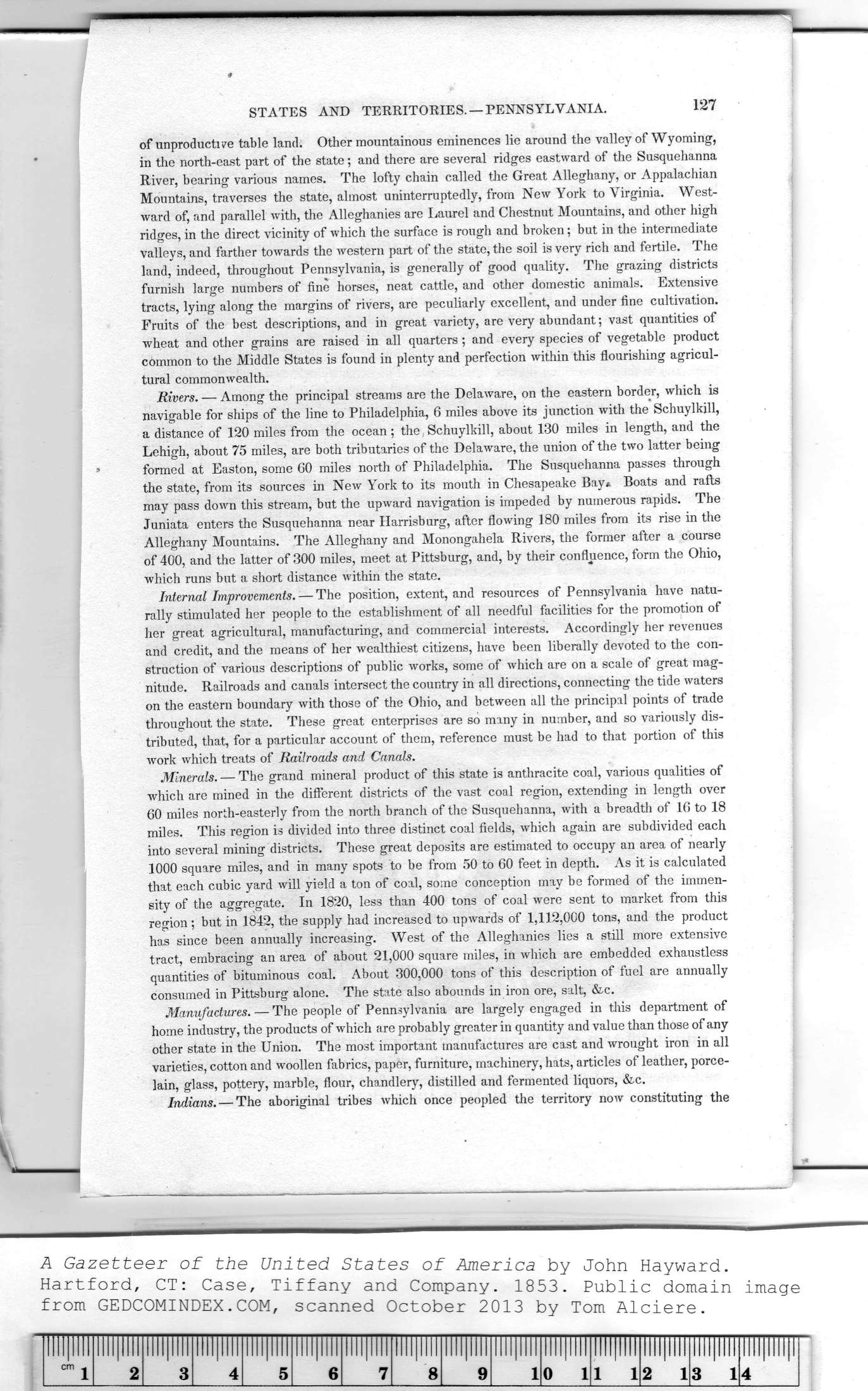|
|
Note: Ctrl and + increases the font size of the text below, Ctrl and - decreases it, and Ctrl and 0 resets it to default size.
STATES AND TERRITORIES. —PENNSYLVANIA. 127
of unproductive table land. Other mountainous eminences lie around the valley of Wyoming,
in the north-east part of the state; and there are several ridges eastward of the Susquehanna
River, bearing various names. The lofty chain called the Great Alleghany, or Appalachian
Mountains, traverses the state, almost uninterruptedly, from New York to Virginia. West-
ward of, and parallel with, the Alleghanies are Laurel and Chestnut Mountains, and other high
ridges, in the direct vicinity of which the surface is rough and broken; but in the intermediate
valleys, and farther towards the western part of the state, the soil is very rich and fertile. The
land, indeed, throughout Pennsylvania, is generally of good quality. The grazing districts
furnish large numbers of fine horses, neat cattle, and other domestic animals. Extensive
tracts, lying along the margins of rivers, are peculiarly excellent, and under fine cultivation.
Fruits of the best descriptions, and in great variety, are very abundant; vast quantities of
wheat and other grains are raised in all quarters ; and every species of vegetable product
common to the Middle States is found in plenty and perfection within this flourishing agricul-
tural commonwealth.
Rivers. — Among the principal streams are the Delaware, on the eastern border, which is
navigable for ships of the line to Philadelphia, 6 miles above its junction with the Schuylkill,
a distance of 120 miles from the ocean; the Schuylkill, about 130 miles in length, and the
Lehigh, about 75 miles, are both tributaries of the Delaware, the union of the two latter being
formed at Easton, some 60 miles north of Philadelphia. The Susquehanna passes through
the state, from its sources in New York to its mouth in Chesapeake Bay*. Boats and rafts
may pass down this stream, but the upward navigation is impeded by numerous rapids. The
Juniata enters the Susquehanna near Harrisburg, after flowing 180 miles from its rise in the
Alleghany Mountains. The Alleghany and Monongahela Rivers, the former after a course
of 400, and the latter of 300 miles, meet at Pittsburg, and, by their confluence, form the Ohio,
which runs but a short distance within the state.
Internal Improvements. — The position, extent, and resources of Pennsylvania have natu-
rally stimulated her people to the establishment of all needful facilities for the promotion of
her great agricultural, manufacturing, and commercial interests. Accordingly her revenues
and credit, and the means of her wealthiest citizens, have been liberally devoted to the con-
struction of various descriptions of public works, some of which are on a scale of great mag-
nitude. Railroads and canals intersect the country in all directions, connecting the tide waters
on the eastern boundary with those of the Ohio, and between all the principal points of trade
throughout the state. These great enterprises are so many in number, and so variously dis-
tributed, that, for a particular account of them, reference must be had to that portion of this
work which treats of Railroads and Canals.
Minerals. — The grand mineral product of this state is anthracite coal, various qualities of
which are mined in the different districts of the vast coal region, extending in length over
60 miles north-easterly from the north branch of the Susquehanna, with a breadth of 16 to 18
miles. This region is divided into three distinct coal fields, which again are subdivided each
into several mining districts. These great deposits are estimated to occupy an area of nearly
1000 square miles, and in many spots to be from 50 to 60 feet in depth. As it is calculated
that each cubic yard will yield a ton of coal, some conception may be formed of the immen-
sity of the aggregate. In 1820, less than 400 tons of coal were sent to market from this
region; but in 1842, the supply had increased to upwards of 1,112,000 tons, and the product
has since been annually increasing. West of the Alleghanies lies a still more extensive
tract, embracing an area of about 21,000 square miles, in which are embedded exhaustless
quantities of bituminous coal. About 300,000 tons of this description of fuel are annually
consumed in Pittsburg alone. The state also abounds in iron ore, salt, &c.
Manufactures. — The people of Pennsylvania are largely engaged in this department of
home industry, the products of which are probably greater in quantity and value than those of any
other state in the Union. The most important manufactures are cast and wrought iron in all
varieties, cotton and woollen fabrics, paper, furniture, machinery, hats, articles of leather, porce-
lain, glass, pottery, marble, flour, chandlery, distilled and fermented liquors, &c.
Indians. — The aboriginal tribes which once peopled the territory now constituting the
|
